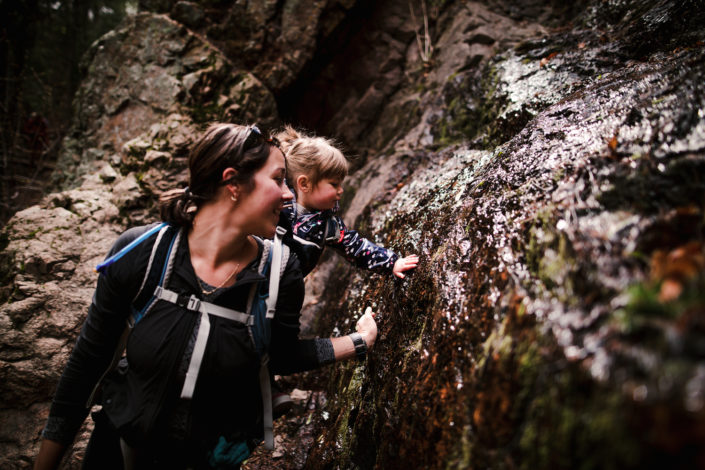Being in the outdoors can help sensory exploration
My 11-month-old son and I were hiking a favorite trail along a picture-perfect mountain stream lined with flowers and full of the smells of summer, the buzz of insects and the roar of rushing water. He was quietly riding on my back when I became aware he was leaning way over to one side. He stopped, but a few minutes later, did it again. I glanced back and realized that he was attempting to grab the tree branches on the edge of the trail as we passed by. So I stopped and let him get ahold of one. His fat little fist hesitated briefly, but in a bold move, he suddenly grabbed the needles, fingered them for a moment, smiled up at me and dropped them.
The next time I felt him leaning, I paused again to let him touch another tree – a friendly fir this time. After that, I began to intentionally look for things he could touch from his perch high on my back: tree bark, smooth leaves, soft flowers, moss, dry grass stems and moisture on the side of a rock. Each pause was brief, but in those moments, my little son got to experience the delights of nature without ever touching the ground.


Explore Each of the Senses with Your Child
We’ve duplicated that experience on many hikes since then, and here’s just a sampling of the things he’s experienced from his carrier: Sight – every color imaginable in countless combinations, light filtering through trees, shadows on the ground, beautiful views and sunshine glistening on water Touch – rough tree bark, smooth glossy leaves, velvety soft flower petals, damp grass, dusty rocks, prickly pine needles, metal fence posts, sun-warmed rocks, spongy moss and crispy dry flowers Smell – smell of water mixed with fresh green plants, rain in the woods, scent of pine in the air on a hot summer day, earthy smell of dirt, sweet scent of flowers in bloom Taste – sweet wild blackberries, thimble berries, tart salmon berries and the occasional rock or stick Hearing – water babbling over rocks in a creek and rushing over waterfalls, birds twittering in the treetops, grass rustling in the breeze, insects humming and buzzing, and people’s voices near and far awaySlowing Down Made Me More Mindful
I discovered that looking for sensory experiences for my son made me a more mindful hiker, too. Additionally, I began to see the variety of textures along the trail, notice the smells and feel the changes in air temperature from sun to shade. I lingered. My appreciation increased. And I saw so much more than if I were simply passing through. Building in brief stops allowed us both to experience so much more on our hikes together. What are some of the senses that you've explored while hiking? Does your child have a favorite sense they like to engage while out? Share with us below.Read More:
Photo by Krystal Weir.Related Content




Comments